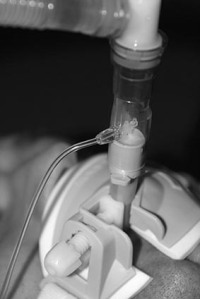Pharmacologically assisted laryngeal mask insertion: a consensus statement
Emerg Med J 2013;30:1073-1075
Management of the pre-hospital airway can be challenging.1 A range of techniques and adjuncts are available to the pre-hospital clinician to aid in their efforts to maximise oxygenation and support ventilation. When measures fail, management is escalated through a series of increasingly complex and invasive procedures (‘the airway management ladder’) with the aim of establishing a definitive airway secured with an endotracheal tube or other surgical airway. In the non-arrested patient the gold standard for definitive pre-hospital airway management is pre-hospital rapid sequence induction and tracheal intubation (RSI) delivered by a competent clinical team.
There may, however, be circumstances in which a pre-hospital RSI cannot be delivered, whether due to lack of clinical capability or lack of access to the patient. Some of these patients may benefit from advanced airway management, with the aim of promoting oxygenation, through the technique of pharmacologically assisted laryngeal mask (PALM) insertion. This technique involves sedating the trauma patient and inserting a supraglottic airway device (SAD) with the aim of improving their oxygenation and providing a degree of protection from ongoing airway contamination.
This article reports the conclusions of a consensus meeting held in April 2012. The meeting followed a full literature search which was presented to the meeting, to which there was an open invitation to all relevant stakeholders. The meeting examined the PALM technique and its indications and outlined the competencies required of practitioners performing the procedure. Key points are:
1. The PALM technique is an acceptable tool for managing the pre-hospital airway.
2. The PALM technique is indicated in a rare set of circumstances.
3. The PALM procedure is a rescue technique.
4. The PALM procedure should be checklist driven.
5. At least a second generation SAD should be used.
6. End-tidal CO2 monitoring is mandatory.
7. No preference is expressed for any particular drug.
8. No preference is expressed for any particular dosing regime
9. Flumazenil is highly unlikely to have a role in managing the PALM patient.
10. The PALM procedure should only be carried out by practitioner of level 7 above.
11. The availability of a trained assistant, familiar with the procedure would be advantageous.
12. The training required, to achieve competency in performing the PALM procedure must include in-hospital insertion of supraglottic airway devices, simulation training and training in the transfer of critically ill patients.
13. Data should be collected and collated at a national level for all patients who receive the PALM procedure.
http://emj.bmj.com/content/30/12/1073.extract
Copies of this statement can be downloaded freely here:
http://www.fphc.co.uk/content/Portals/0/Documents/2013-12%20PALM%20Consensus%20COMPLETE.pdf


